
Every successful business needs a solid plan. For marketers, this often boils down to a core concept: the Marketing Mix 4 Ps. This fundamental framework guides how companies bring their products or services to customers. It ensures everything aligns for optimal impact and profit.
The 4 Ps stand for Product, Price, Place, and Promotion. Mastering these four elements is crucial. They work together like pieces of a puzzle. Get them right, and your business can thrive. Neglect one, and your strategy might falter. Let’s delve into each P, understanding their individual power and collective synergy.
The Marketing Mix: A Strategic Blueprint
The marketing mix provides a roadmap. It helps firms create a winning combination. This means having the right product. It must sell at the right price. Goods need to be in the right place. Finally, they require the most suitable promotion. Achieving this mix involves meeting key conditions.
Firstly, the product must feature correctly. It needs a good appearance. It must also work effectively. Secondly, the price has to be appropriate. Consumers must buy in large numbers. This generates a healthy profit. Thirdly, goods need to be in the right place. They must arrive at the correct time. Ensuring this timely delivery is vital. Lastly, your target group needs awareness. They must know the product exists. Successful promotion helps spread costs. It leads to larger output and sales.
Consider a company like Kellogg’s. They constantly develop new breakfast cereals. The new cereal itself is the product. Setting the price involves several factors. They examine customer perceptions. Rival products and manufacturing costs are also key. Promotion includes various activities. Competitions and product tasting are common examples. Place means using the best distribution channels. Leading supermarket chains are essential here.
The marketing mix isn’t just theory. It’s a practical tool. It ensures businesses connect with their customers. It drives sales and builds brand loyalty. Understanding its components is the first step towards market mastery.
Product: The Heart of Your Offering
The product forms the central point of all marketing energy. It is what a company offers to satisfy customer needs or wants. This could be a physical good. It might be a service or even an idea. Marketing focuses on what the product means to the customer. It shapes key aspects of the product’s identity.
Product Features and Design: Marketing plays a vital role here. It helps determine the product’s appearance. This must align with market requirements. The product’s function is equally important. Products must address customer needs. Market research identifies these needs. For example, a new smartphone needs an intuitive design. It also needs features that users genuinely want. Without meeting these expectations, sales will suffer.
Product Range and Diversification: A company’s product range comes from its marketing mix. This range might broaden for tactical reasons. It could match competitor offerings. It may cater to seasonal fluctuations. Imagine a clothing brand. They might add a winter collection. This serves a specific seasonal demand. Alternatively, a brand may extend. This is often part of a long-term plan. It could involve repositioning a product. This makes it more acceptable to a new group of consumers. For example, a sports drink might target casual exercisers. Initially, it might have only focused on elite athletes.
Branding and Packaging: These are crucial parts of the product P. A strong brand name helps recognition. It builds customer loyalty. Packaging protects the product. It also attracts attention. It conveys information to the consumer. Think about premium food items. Their packaging often signals quality. It promises a specific experience. Effective branding creates an emotional connection. It differentiates your product in crowded markets.
Product Life Cycle: Products move through distinct stages. These include introduction, growth, maturity, and decline. Marketing strategies adapt at each stage. In the introduction, focus on awareness. During growth, aim for market share. At maturity, defend your position. In decline, consider phasing out or revitalising. Understanding this cycle helps businesses manage their portfolio. It ensures continuous innovation.
Service as a Product: Many businesses offer services. These are intangible products. Marketing services require unique approaches. You must highlight benefits. Emphasise quality and reliability. Customer experience is paramount. Think about a haircut or a banking service. The “product” is the service itself. Its delivery and quality define its value.
Price: The Revenue Driver
Of all the Marketing Mix 4 Ps, price is unique. It directly creates sales revenue. All other Ps are costs. The price of an item profoundly impacts sales value. In theory, price comes from customer perception. It reflects the value they place on an item.
Understanding Perceived Value: Researching consumer opinions on pricing is vital. It shows how customers value what they seek. It also indicates what they are willing to pay. An organisation’s pricing policy changes. It varies according to time and circumstances. Water in the Lake District has little value. Water in the desert has immense value. This simple example highlights context.
Pricing Strategies: Businesses use various pricing strategies:
- Cost-Plus Pricing: You add a profit margin to production costs. It’s simple but ignores market demand.
- Competitive Pricing: You set prices based on rivals. This is common in crowded markets.
- Value-Based Pricing: You base the price on perceived customer value. This often allows for higher prices.
- Psychological Pricing: You use pricing to appeal to emotions. Prices ending in .99 pence are common.
- Skimming Pricing: You set a high initial price. This targets early adopters. Price then drops over time.
- Penetration Pricing: You set a low initial price. This aims to gain market share quickly.
Factors Influencing Pricing Decisions: Many factors influence pricing. These include production costs. Competitor pricing is crucial. Perceived customer value is also key. Economic conditions play a role. Inflation and interest rates affect pricing power. Government regulations can impact prices, too. Ethical considerations are increasingly important. The price is too high, and you lose customers. The price is too low, and you lose profit. Finding the balance is an art. It requires continuous monitoring.
Place: Getting It to the Customer
The place element deals with distribution. It ensures goods reach the customer. This involves various methods of transport. It also includes storing goods. Roughly a fifth of a product’s cost goes to distribution. This figure varies widely by product type.
Distribution Channels: Getting the right product to the right place is complex. It must arrive at the right time. This relies on the distribution system. The choice of method depends on many factors. Some manufacturers sell to wholesalers. Wholesalers then sell to retailers. This is an indirect channel. Others prefer to sell directly. They might sell straight to retailers or customers. This is a direct channel.
Common distribution channels include:
- Direct Selling: Manufacturers sell straight to consumers. This includes online stores, direct mail, or door-to-door sales.
- Retailers: Companies sell to shops that then sell to consumers. Supermarkets and department stores are examples.
- Wholesalers: Businesses buy in bulk from manufacturers. They then sell to retailers. This simplifies distribution for manufacturers.
- Agents/Brokers: They facilitate sales without taking ownership of goods. They earn commissions.
Logistics and Supply Chain Management: Place is about more than just channels. It encompasses logistics. This includes warehousing goods. It manages inventory levels. It ensures efficient transport. Effective supply chain management minimises delays. It reduces costs. It guarantees product availability. A well-managed supply chain builds customer satisfaction. It also provides a competitive edge.
Market Coverage: Businesses decide on market coverage. This impacts their “place” strategy.
- Intensive Distribution: Products are available everywhere. This is for convenience goods like soft drinks.
- Selective Distribution: Products are available in a limited number of outlets. This maintains a certain brand image.
- Exclusive Distribution: Products are sold through only one or very few outlets. This is for luxury goods. It offers tight control over brand image.
Promotion: Communicating Value
Promotion is the art of communicating with customers. It provides information. This information helps them decide to buy. It builds brand awareness. It persuades potential customers. The pace and creativity of some promotional activities are striking. They often seem far removed from normal business.
Cost-Effectiveness of Promotion: The cost of promoting goods and services can be substantial. It often represents a large proportion of a product’s overall cost. However, successful promotion increases sales. This spreads advertising and other costs over a larger output. Though increased activity might signal a problem, like competitive pressure, it builds brand messaging. It can be extremely cost-effective in the long run.
Promotional Tools: Businesses use various tools for promotion:
- Advertising: This involves paid communication. TV, radio, print, and digital ads are common.
- Public Relations (PR): This builds a positive public image. Press releases, events, and community involvement are examples.
- Sales Promotion: Short-term incentives drive sales. Discounts, coupons, and contests fall into this category.
- Personal Selling: Direct interaction between a salesperson and a customer. This is common for complex products.
- Digital Marketing: Websites, social media, email campaigns, and SEO are key. This is crucial in today’s digital age.
- Content Marketing: Creating valuable, relevant content. This attracts and retains a target audience. Blogs, videos, and guides are examples.
Integrated Marketing Communications (IMC): Modern promotion aims for IMC. This means all promotional messages are consistent. They work together across different channels. This creates a clear and unified brand message. It maximises impact and avoids confusion.
The Marketing Mix in Action: Vodafone and Manchester United
Let’s examine how two global brands, Vodafone and Manchester United, used the 4 Ps through their strategic partnership. This alliance, announced in February 2000, saw Vodafone become the principal sponsor and telecommunications partner of the club.
Product: For Manchester United, the “product” extends far beyond the football team itself, which aims to play and win excitingly. It encompasses the entire fan experience. This includes vast merchandising, such as the sale of official shirts and various memorabilia. Television rights are crucial, contributing to the club’s own television channel. Vodafone, in turn, developed new, value-added services specifically for Manchester United fans, like manUmobile. This service allowed fans direct mobile access to club news, fixture lists, match information, and ticket availability, enhancing the fan’s “product” experience. Vodafone also offered Manchester United branded phones and accessories, expanding its own product range.
Place: Old Trafford serves as the primary “place” for Manchester United’s home games. However, the club also plays at various other venues globally, extending its reach. Its products, from shirts to keyrings, are sold worldwide through the club’s website and other sales media. This global distribution strategy is key to their expansive fan base. For Vodafone, the partnership’s “place” aspect meant exposing their brand in countries where it might not have been previously known, leveraging Manchester United’s global appeal.
Promotion: Manchester United actively markets itself as a global brand. The club engages in various promotional activities. The partnership with Vodafone involved Vodafone’s logo on the playing kit, rights to use the Manchester United logo in promotions and advertising, and perimeter signage at home games. Vodafone also featured prominently in Manchester United’s marketing materials, including match programmes, the club magazine, and its website. This association added excitement, passion, and emotion to the Vodafone brand, helping to promote and enhance it.
Price: Manchester United positions itself at the upmarket, premier end of the football market. Consequently, it charges premium prices, evident in the high cost of a season ticket for home league games. This premium pricing strategy aligns with its global brand image and pursuit of excellence. For Vodafone, the £30 million, four-year sponsorship deal was a significant investment. However, it was strategically priced to achieve marketing objectives: obtaining new customers, retaining existing ones, and developing the Vodafone brand globally by associating with a renowned sporting team.
This case study vividly demonstrates how the 4 Ps interrelate. They combine to create a powerful, consistent, and globally impactful market presence for both Manchester United and Vodafone.
Repositioning a Product
Positioning a product means locating it within a market. This might involve presenting it as upmarket or downmarket. It could target younger or older consumers. Repositioning changes this perception. It makes a product more acceptable to a new group. This often forms part of a long-term plan. It’s a strategic move to capture new market segments.
Conclusion: Mastering Your Marketing Mix
The Marketing Mix 4 Ps are foundational. They are not merely an academic concept. They are practical tools for any business. From small start-ups to global giants, they guide strategic decisions. Understanding and effectively managing Product, Price, Place, and Promotion is vital.
It ensures that a business meets customer needs. It optimises revenue generation. It places products where customers can find them. It communicates value effectively. In today’s dynamic marketplace, businesses must continuously refine their marketing mix. This adaptability ensures long-term success. It allows them to respond to market changes. It builds strong customer relationships. Master the 4 Ps, and you master your market.
FAQs
The 4 Ps of the Marketing Mix are Product, Price, Place, and Promotion, which are essential elements businesses control to market their offerings successfully.
The Product element is central because it defines what the company offers to meet customer needs, including its features, design, branding, and packaging, all crucial for market success.
Price directly generates sales revenue and significantly impacts sales value, influenced by customer perception of value, competitor pricing, and various strategic approaches like cost-plus or value-based pricing.
‘Place’ refers to distribution, encompassing the methods of transporting, storing, and making products available to customers at the right time and location, involving choices like direct selling or retail channels.
The main goal of Promotion is to communicate with customers, provide information to assist their purchasing decisions, build brand awareness, and ultimately increase sales by spreading costs over a larger output.
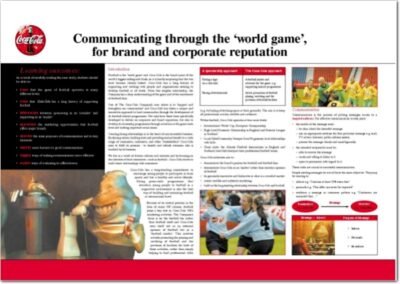 Communicating through the "world game", for brand and corporate reputation (PDF)
Communicating through the "world game", for brand and corporate reputation (PDF)  Responding to changing customer requirements: the drive towards Wellness (PDF)
Responding to changing customer requirements: the drive towards Wellness (PDF)  Foreign Commonwealth Office A3 ePoster Edition 14 "Delivering the mission statement"
Foreign Commonwealth Office A3 ePoster Edition 14 "Delivering the mission statement"  Strategy in action - healthy schools (PDF)
Strategy in action - healthy schools (PDF) 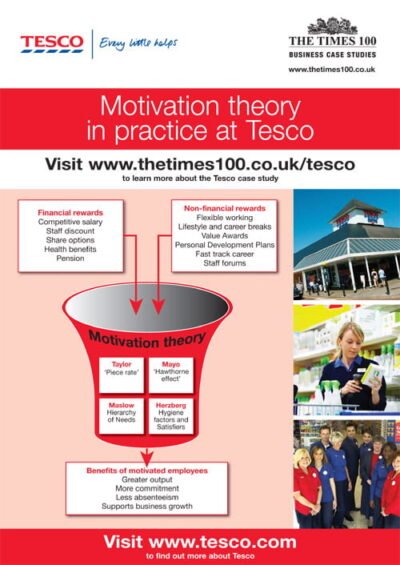 Tesco A3 ePoster Edition 15 "Motivation theory in practice at Tesco"
Tesco A3 ePoster Edition 15 "Motivation theory in practice at Tesco" 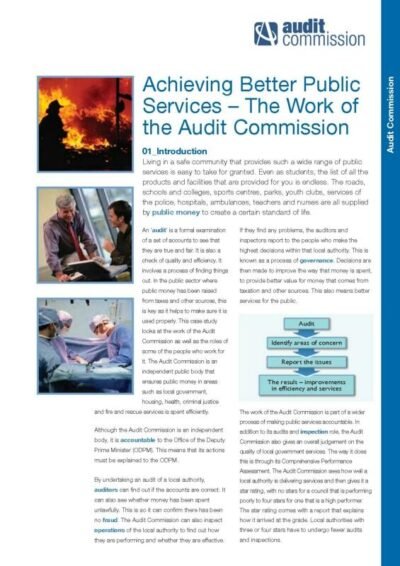 Achieving Better Public Services - The Work of the Audit Commission (PDF)
Achieving Better Public Services - The Work of the Audit Commission (PDF) 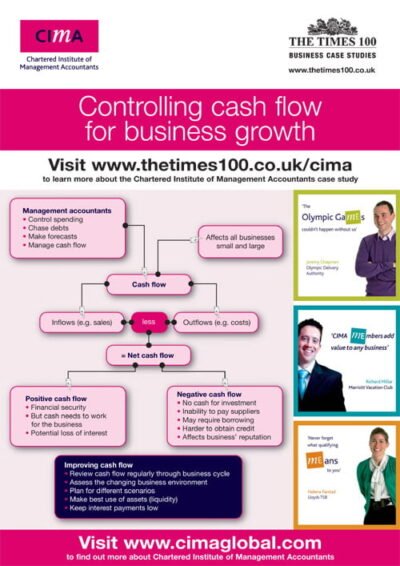 CIMA A3 ePoster Edition 15 "Controlling cash flow for business growth"
CIMA A3 ePoster Edition 15 "Controlling cash flow for business growth" 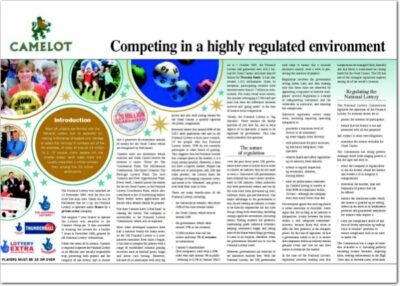 Competing in a highly regulated environment (PDF)
Competing in a highly regulated environment (PDF) 